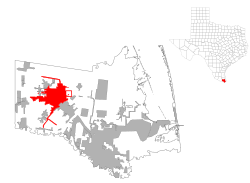Harlingen, Texas
| Harlingen, Texas | |||||
|---|---|---|---|---|---|
| City | |||||
| City of Harlingen | |||||

The Harlingen Cold Storage Plant building in September 2012.
|
|||||
|
|||||
| Nickname(s): "The Capital of the Rio Grande Valley", "H-Town" | |||||
 Location in the U.S. state of Texas |
|||||
| Coordinates: 26°12′N 97°42′W / 26.200°N 97.700°WCoordinates: 26°12′N 97°42′W / 26.200°N 97.700°W | |||||
| Country | United States of America | ||||
| State | Texas | ||||
| County | Cameron | ||||
| Founded | 1904 | ||||
| Government | |||||
| • Type | Council-Manager | ||||
| • Mayor | Christopher Boswell | ||||
| • City Manager | Dan Serna | ||||
| Area | |||||
| • City | 40.3 sq mi (104.4 km2) | ||||
| • Land | 39.8 sq mi (103.1 km2) | ||||
| • Water | 0.5 sq mi (1.3 km2) | ||||
| Elevation | 39 ft (12 m) | ||||
| Population (2010) | |||||
| • City | 74,849 | ||||
| • Density | 1,629/sq mi (629.0/km2) | ||||
| • Metro | 406,220 | ||||
| Time zone | CST (UTC-6) | ||||
| • Summer (DST) | CDT (UTC-5) | ||||
| ZIP codes | 78550-78553 | ||||
| Area code(s) | 956 | ||||
| FIPS code | 48-32372 | ||||
| GNIS feature ID | 1337354 | ||||
| Website | myharlingen |
||||
Harlingen (/ˈhɑːrlᵻndʒᵻn/ HAR-lin-jin) is a city in Cameron County in the heart of the Rio Grande Valley of southern Texas, United States, about 30 miles (48 km) from the coast of the Gulf of Mexico. The city covers more than 40 square miles (104 km2) and is the second largest city in Cameron County, as well as the fourth largest in the Rio Grande Valley. As of the 2010 census the city had a population of 64,849, for a growth rate of 12.5% since the 2000 census. It is the city with the least expensive cost of living in the United States.
Harlingen is a principal city of the Brownsville–Harlingen metropolitan area, which is part of the larger Brownsville-Harlingen-Raymondville combined statistical area, included in the Matamoros–Brownsville metropolitan area.
Harlingen's strategic location at the intersection of U.S. Route 77 and U.S. Route 83, designated as Interstate 69 East and Interstate 2 respectively, in northwestern Cameron County fostered its development as a distribution, shipping, and industrial center. In 1904 Lon C. Hill (a man of Choctaw ancestry) envisioned the Arroyo Colorado as a commercial waterway. He named the town he founded on the north bank after the Frisian city of Harlingen, the Netherlands. The town's post office was established that year. The first school opened with fifteen pupils in 1905 near the Hill home, the first residence built in Harlingen. Harlingen incorporated on April 15, 1910, when the population totaled 1,126. In 1920 the census listed 1,748. The local economy at first was almost entirely agricultural. Major crops were vegetables and cotton.
...
Wikipedia


